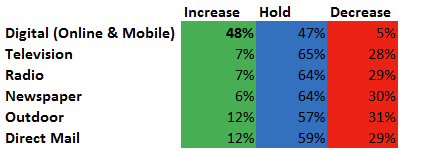1. Create an engaging dealership website that is easy to navigate
2. Make your website mobile friendly
3. Make sure your inventory is accurate
5. Track all of your traffic with an analytics tool
With print publications and other traditional media outlets on the decline, today’s car shoppers are heavily reliant on the internet to help inform their decisions. As seen across other industries, failure to stay up to date with digital trends and to evolve can lead to extinction.
A great example would be Blockbuster, which dominated the movie rental industry in the 90s and early 2000s. Then Netflix came along, and took Blockbuster’s business model and improved upon it through digitization. Blockbuster wasn’t able to pivot quickly enough, and was left in the dust.
According to the NIADA Q2 Business Confidence Survey, 48% of car dealerships are planning on increasing their digital marketing presence within the next quarter. In contrast, only 12% plan to increase their direct mail marketing, while 7% and 6% plan to increase their spending on TV and newspaper ads respectively.

Source: NIADA Q2 Business Confidence Survey
Overall, about 30% of dealerships plan on minimizing efforts in TV, newspaper, and direct mail channels this quarter, while only 5% plan on decreasing efforts in digital marketing! With this in mind, how can a dealership stay competitive online in the evolving digital realm?
1. Create an engaging dealership website that is easy to navigate
Many car dealership websites today are essentially digital advertisements and are not any different than a print ad you may see in a magazine.
While this may seem fine, a website has a lot more potential that just being a static ad. Creating an engaging site will encourage potential customers to stay on it longer, which can increase the chance of a sale. You can start by consulting with your sales team to see what issues or questions customers commonly ask and address these questions or concerns on your site.
In addition, nothing ruins a site’s user experience more than difficult navigation. A shopping experience should be simple and straightforward. If a potential customer is unsure of how to view your inventory, find your contact information, or just go from page to page, you have a problem and you could be losing out on business.
Get perspective from people outside your business and have them browse your site to see if they have an easy time finding what they are looking for. Your website often provides the first impression a potential customer has of your dealership, so take advantage and optimize it to its full potential. The digital space is still relatively new and evolving for many local businesses so taking action to deliver a stable and intuitive user experience that is easy to search, navigate and transact on can help you beat out competitors and drive more business.
2. Make your website mobile friendly
We are quickly becoming a mobile first world and having a responsive or mobile friendly site that is easy to use and loads quickly on the go is highly important. In addition, consumers now live in an “on-demand” culture where impatience, especially for frustrating websites, sends users and their dollars the other way.
According to SimilarWeb’s State of Mobile Web US 2015 report, mobile device traffic is roughly 56% of total consumer traffic going to US based websites. With the majority of traffic now coming from mobile, you need to make sure your visitors will have a good mobile experience. A solid user experience along with fast performance across devices will lead to higher engagement, lower bounce rates, better SEO rankings and more customers!
3. Make sure your inventory is accurate
Nothing is more frustrating than a misleading or an outdated advertisement. Make sure your car selection on your website is up to date and that it reflects all current deals. If you’re using DealerCenter’s dealer management system, you can easily manage this and every aspect of your inventory including publishing your vehicles online to any popular website. In addition, if you are using our website template, the cars posted through our platform are automatically reflected in your inventory.
4. Use a loan calculator
Having a payment calculator helps your customers determine their potential car payments. and see what types of deal structure aligns with their financial situation The customer simply needs to enter the price of the vehicle, their credit score/interest rate, the down payment and term to view their estimated monthly payments. The calculator also gives customers a better idea of their personalized payment options.
5. Track all of your traffic with an analytics tool
Utilizing data in the digital space is essential to making better business decisions. By analyzing your data, you can get an overall view on how your site is converting and where you may need to improve. For example, if a large number of viewers are quickly bouncing from your homepage, you probably need to improve the layout or design to encourage potential customers to continue browsing.
If you’re using DealerCenter’s dealer website, you can easily link your Google Analytics account to monitor the activity on your site. Alternatively, if you don’t have Google Analytics, there is an analytics dashboard on DealerCenter’s dealer website that provides you with basic metrics.
Regardless, data paints the picture of your online performance, and if you’re not actively tracking and reporting your statistics, you could be losing out on sales.
* This blog post was originally published on 12/21/2016 on dealercenter.com









